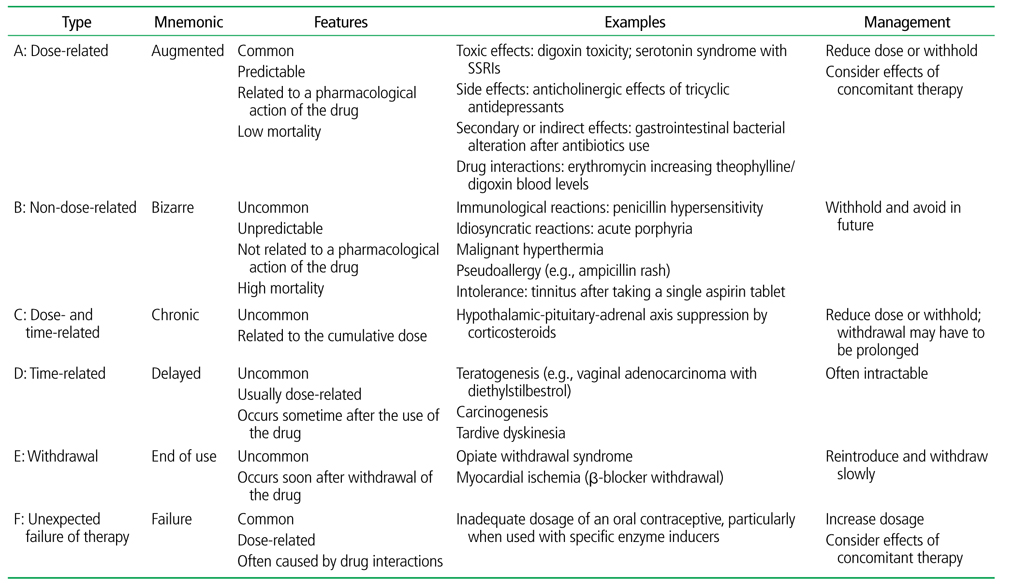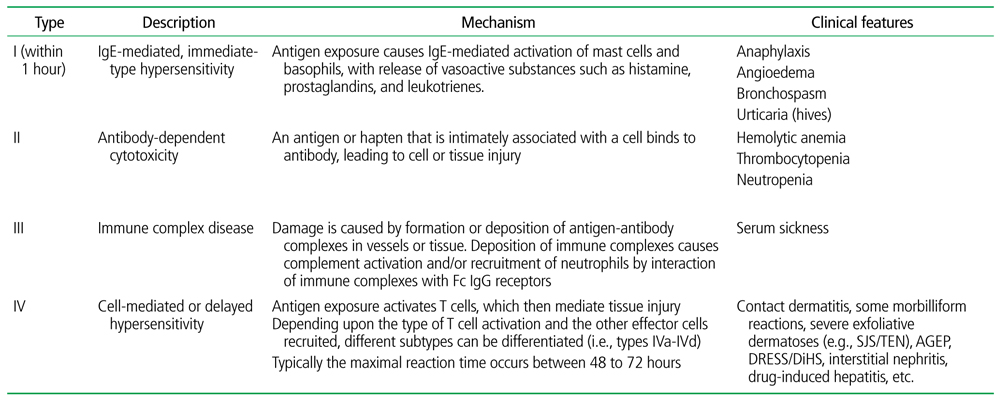 |
 |
- Search
| J Korean Med Assoc > Volume 62(9); 2019 > Article |
|
Abstract
There are no drugs without the risk of potential adverse reactions. All pharmacologically active substances can cause adverse drug reactions (ADRs). This paper aims at introducing recent trends in pharmacosurveillance systems for ADRs, which can be broadly classified into type A and B reactions. Since type A reactions are associated with drug pharmacology, they are usually dose-dependent and predictable. Whereas, type B reactions occur in some susceptible individuals, regardless of the pharmacological action of drug. Drug hypersensitivity reactions are typical examples of type B reactions and are subclassified according to the underlying pathomechanism. Recent advancements in pharmacogenomics have enlightened the understanding of individual differences in drug efficacy and susceptibility to ADRs. Therefore, expectations for safe personalized medicines are higher than ever before. However, premarketing clinical trials are too small and too short to uncover rare but serious ADRs and detect long-standing ADRs. In the past, post-marketing surveillance systems mainly focused on passive ADR monitoring systems, based on spontaneous reports. Recently, the importance of active pharmacovigilance systems, which use big data, is growing with recent advancements in medical informatics. Thus, regarding ADRs, suspecting and detecting the causative drug using causality assessment based on data science may contribute to decrease suffering induced by ADRs.
References
1. Kim SJ, Chung SY, Park BJ. Pharmacovigilance organization and activity of WHO-UMC. J Pharmacoepidemiol Risk Manag 2014;7:1-6.
2. International drug monitoring: the role of national centres: report of a WHO meeting. World Health Organ Tech Rep Ser 1972;498:1-25.

3. World Health Organization. The importance of pharmacovigilance: safety monitoring of medicinal products [Internet] Geneva: World Health Organization. 2002;cited 2019 Jen 18. Available from: https://apps.who.int/medicinedocs/en/d/Js4893e/
4. Gomes ER, Demoly P. Epidemiology of hypersensitivity drug reactions. Curr Opin Allergy Clin Immunol 2005;5:309-316.


5. Yang MS, Ban GY, Kim MH, Lim KH, Kwon HS, Song WJ, Jung JW, Lee JM, Suh DI, Kwon JW, Kim SH, Shin YS, Kang HR, Kim TB, Lee BJ, Lee AY, Park HS, Cho SH. KAAACI Standardization Committee Report on the procedures and applications of the diagnostic tests for drug allergy. Allergy Asthma Respir Dis 2017;5:239-247.


6. Edwards IR, Aronson JK. Adverse drug reactions: definitions, diagnosis, and management. Lancet 2000;356:1255-1259.


7. Hartigan-Go KY, Wong JQ. Inclusion of therapeutic failures as adverse drug reactions. Side Eff Drugs Annu 2000;23:xxvii-xxxiii.

8. Weiss ME, Adkinson NF. Immediate hypersensitivity reactions to penicillin and related antibiotics. Clin Allergy 1988;18:515-540.


9. McNeil BD, Pundir P, Meeker S, Han L, Undem BJ, Kulka M, Dong X. Identification of a mast-cell-specific receptor crucial for pseudo-allergic drug reactions. Nature 2015;519:237-241.




10. Demoly P, Adkinson NF, Brockow K, Castells M, Chiriac AM, Greenberger PA, Khan DA, Lang DM, Park HS, Pichler W, Sanchez-Borges M, Shiohara T, Thong BY. International consensus on drug allergy. Allergy 2014;69:420-437.


12. Jang IJ. Introduction to clinical pharmacogenetics. J Korean Soc Clin Pharmacol Ther 2007;15:5-19.


13. Wilkinson GR. Drug metabolism and variability among patients in drug response. N Engl J Med 2005;352:2211-2221.


14. Koren G, Cairns J, Chitayat D, Gaedigk A, Leeder SJ. Pharmacogenetics of morphine poisoning in a breastfed neonate of a codeine-prescribed mother. Lancet 2006;368:704.


15. Jung JW, Kim JY, Park IW, Choi BW, Kang HR. Genetic markers of severe cutaneous adverse reactions. Korean J Intern Med 2018;33:867-875.




16. Park WB, Choe PG, Song KH, Lee S, Jang HC, Jeon JH, Park SW, Park MH, Oh MD, Choe KW. Should HLA-B*5701 screening be performed in every ethnic group before starting abacavir? Clin Infect Dis 2009;48:365-367.


17. Jung JW, Song WJ, Kim YS, Joo KW, Lee KW, Kim SH, Park HY, Chang YS, Sho SH, Min KU, Kang HR. HLA-B58 can help the clinical decision on starting allopurinol in patients with chronic renal insufficiency. Nephrol Dial Transplant 2011;26:3567-3572.


18. Jung JW, Kim DK, Park HW, Oh KH, Joo KW, Kim YS, Ahn C, Lee KW, Cho SH, Min KU, Kang HR. An effective strategy to prevent allopurinol-induced hypersensitivity by HLA typing. Genet Med 2015;17:807-814.



19. Kim SH, Kim M, Lee KW, Kim SH, Kang HR, Park HW, Jee YK. HLA-B*5901 is strongly associated with methazolamide-induced Stevens-Johnson syndrome/toxic epidermal necrolysis. Pharmacogenomics 2010;11:879-884.


20. Kim S, Yun J, Kang DY, Park HJ, Jo EJ, Jung JW, Park HK, Park JW, Jee YK, Kang HR, Lee JM. Carbonic anhydrase inhibitor-induced Stevens-Johnson syndrome/toxic epidermal necrolysis leads to extensive cutaneous involvement. J Allergy Clin Immunol Pract 2019;05. 22. 10.1016/j.jaip.2019.05.010. [Epub].

21. Choi NK, Park BJ. Adverse drug reaction surveillance system in Korea. J Prev Med Public Health 2007;40:278-284.


23. Kim SJ, Kim JY, Song EH, Cho MJ, Lee KJ, Jung SY, Han SY. Introduction of current status of the adverse drug reaction relief system in Korea, Japan and Taiwan. J Pharmacoepidemiol Risk Manag 2019;11:1-8.
Table 1
Classification of adverse drug reactions

Adapted from Edwards IR et al. Lancet 2000;356:1255-1259 [6].
SSRI, serotonin-selective reuptake inhibitor.
Table 2
Classification of drug hypersensitivity reactions

Adapted from Weiss ME et al. Clin Allergy 1988;18:515-540 [8].
SJS, Steven-Johnson syndrome; TEN, toxic epidermal necrosis; AGEP, acute generalized exanthematous pustulosis; DRESS, drug reaction with eosinophilia and systemic symptoms; DiHS, drug-induced hypersensitivity syndrome.
Table 3
World Health Organization-Uppsala Monitoring Center causality categories

Adapted from Edwards IR et al. Lancet 2000;356:1255-1259 [6].
- TOOLS
-
METRICS

-
Related articles in
J Korean Med Assoc -
Cutaneous adverse drug reactions2023 January;66(1)
Inhibitory Drug Interaction1997 January;40(1)
Gene Structure and Function1998 September;41(9)
Foodborne Infections2002 August;45(8)
Active Participation in Reporting Adverse Drug Reactions2002 November;45(11)






